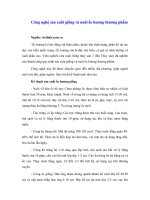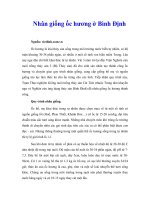不同底质对方斑东风螺生长及存活的影响 Ốc hương Babylonia
Bạn đang xem bản rút gọn của tài liệu. Xem và tải ngay bản đầy đủ của tài liệu tại đây (472.29 KB, 6 trang )
不同底质对方斑东风螺生长及存活的影响
郑纪盟 1, 2, 高霄龙 1, 2, 邱天龙 1, 3, 刘
(1.
,
,
鹰 1, 3, 4
266071; 2.
,
100049; 3.
266071; 4.
,
226019)
摘要: 比较了自然沙、棕色陶粒、白色陶粒、70%棕色陶粒+30%贝壳砂、贝壳砂等 5 种底质材料及空
白对照组(无底质), 对体质量为 0.193 g±0.03 g 的方斑东风螺生长、存活、摄食以及培育过程中水质的
影响。结果表明, 白色陶粒组的存活率为 80%, 显著低于其他各组(P<0.05); 棕色陶粒组的体质量特定
生长率最高(4.31%/d), 且显著优于白色陶粒组和对照组(P<0.05); 棕色陶粒处理组方斑东风螺的饵料
转化效率显著高于白色陶粒组和空白对照组; 水质中总氨氮、亚硝酸氮和 COD 均呈上升趋势, 各组之
间差异不显著。
关键词: 方斑东风螺(Babylonia areolata); 底质; 生长; 存活
中图分类号: S968.31
文献标识码: A
文章编号: 1000-3096(2015)11-0001-06
doi: 10.11759/hykx20150805004
(Babylonia areolata)
,
,
1000 t
,
[1]
70%
,
+30%
5
,
(
)
,
,
,
,
,
,
[2]
1
,
,
,
1.1
材料与方法
实验材料
,
,
,
,
,
,
8: 00
,
,
,
(0.193±0.031)g,
,
(9.727±0.795)mm,
(5.817±0.370) mm
,
1.2
,
实验设计与养殖管理
[3]
,
,
[4]
,
,
,
,
[5-6]
: 2015-08-05;
:
(CARS-48);
2011BAD13B04);
:
(1988-)
;
,
: 2015-09-12
(BE2015325);
,
,
:
,
,
(2014BAD08B09,
(13-CX-16)
, E-mail:
:
, E-mail:
Marine Sciences / Vol. 39, No. 11 / 2015
1
W1 W 0
3
:
5
(CS)
(BS)
+30%
(
BSS)
,
1
, t
, I
(
,
:
10 cm
(Total ammonia nitrogen,
[8]
TAN)
NO 2
(
4.94~54.94.98 lx),
12D: 12L(7: 30
, 19:
-N)
1.4
-
[10]
数据处理与分析
±
2.612
(BS)
0.25~0.5
2.043
(WS)
0.25~0.5
2.341
0.25~1
1.790
,
,
Duncan
2
2.1
(P<0.05)
80%
,
95%,
26.4
(93.3%)
±0.5℃,
(90%)
28 d
-
(91.7%)
(90%),
(P<0.05)
8
28
,
(P<0.05),
12%~14 %
,
P<0.05
1
(Trachypenaeus
26~30
,
底质对方斑东风螺存活的影响
,
curvirostris),
SPSS19.0
实验结果
0.5 h
1.5 h
,
(One-ANOVA),
(103 kg/m3)
0.25~0.5
(SS)
(Nitrite,
[9]
表 1 不同底质的物理性质
Tab. 1
Physical characteristics of substrates
(CS)
,
(CODMn)
)
(mm)
:
)
3L
5cm
,
B0
4
20
30
B1
,
(SS)
3
,
H0
), H1
(WS) 70%
-
(NS),
(
,
15
22
(
)
,
10
1.3
指标与测定方法
:
(Survival rate,
SR)
(Specific growth rate, SGR1)
(SGR2)
(SGR3)
(Feed intake, FI)
(Feeding rate, FRd)
(Feed conversion efficiencies , FCEd),
[7]
Fig.1
:
SR(%)=(N0
(P>0.05),
Nt)/N0×100%
SGR1(%/d)=(lnW1
lnW0)/t×100%
SGR2(%/d)=(lnH1
lnH0)/t×100%
(P<0.05,
2.2
SGR3(%/d)=(lnB1 lnB0)/t×100%
FRd(%/d)=I/[t×(W1+W0)/2] ×100%
FCEd(%)=(W1 W0)/I
, Nt
2
1
Effect of different substrates on the survival of B.
areolata
)
底质对方斑东风螺生长的影响
2
t
(P<0.05)
,
/ 2015
/
39
/
11
表 2 底质对方斑东风螺特定生长率的影响
Tab.2 Effect of different substrates on specific growth rate of B. areolata
SGR1(%/d)
(CS)
3.7803±0.3577
abc
3.9530±0.4829
ab
(SS)
-
SGR2(%/d)
SGR3(%/d)
1.2864±0.0495
b
1.428±0.1130b
1.2124±0.0691
b
1.400±0.0571b
(WS)
3.6189±0.0842bc
1.2010±0.0356b
1.4045±0.1021b
(BS)
4.3114±0.2571a
1.4623±0.0964a
1.6889±0.0967a
c
b
1.1786±0.0401c
1.2962±0.0974b
1.5533±0.0912ab
(NS)
3.2808±0.3297
(BSS)
4.1013±0.2324 ab
:
1.1711±0.0743
(P>0.05),
,
(P<0.05)
4.31%/d,
(P<0.05);
,
-
,
(P>0.05)
(P<0.05),
(P>0.05);
-
,
(P<0.05);
(P<0.05)
2.3
Fig.3
3
Feeding conversion efficiencies (FCE) of B. areolata
under different substrates
2.4
底质对方斑东风螺养殖水质的影响
底质对方斑东风螺摄食的影响
(FR)
(P<0.05,
2)
4
,
,
,
TAN
(P<0.05)
(P>0.05)
(P>0.05),
28
21 d
,
TAN
(P<0.05)
TAN
-
TAN
TAN
,
0.4 mg/L
TAN
Fig.2
2
Feeding rate (FR) of B. areolata under different substrates
3
,
28.16%, 49.83%(P<0.05)
-
Fig. 4
4
TAN
Fluctuation of TAN concentration under different
substrates
NO 2 -N
,
(
,
(P>0.05)
Marine Sciences / Vol. 39, No. 11 / 2015
,
-
5, P<0.05)
NO 2
-N
14 d
,
3
(P<0.05)
NO 2
21
-
)
-N
,
0.25~0.063mm
NO 2
(P>0.05),
;
28
;
[13]
-N
,
,
[13]
(P<0.05)
6
,
,
,
,
, 5
,
,
,
2
,
Fluctuation of NO -N concentration under different
substrates
,
,
COD
(
6, P<0.05)
7
,
,
21
COD
14
(P<0.05),
,
-
COD
28
,
,
(P>0.05);
COD
(P>0.05)
;
NO 2 -N
5
Fig. 5
,
,
,
,
COD
,
(P<0.05),
,
[14]
(P>0.05)
, COD
,
,
Ca2+
,
Ca
,
2+
Ca2+
,
,
[15]
CaO,
[16]
Ca2+
Fig. 6
3
6
COD
Fluctuation of COD concentration under different
substrates
,
,
,
讨论
,
,
[11]
(
,
4
)
,
,
,
,
;
4
[12]
3
[17]
(
/ 2015
/
39
/
11
30
29~30℃
28
,
9.39 mg/L
[18]
28
[J].
,
[4]
,
,
,
-
.
[J].
[5]
TAN
, 2006, 3: 8-12.
, 2011, 4: 27-30.
,
,
,
.
TAN
TAN
[J].
(
,
), 2012, 2: 29-32.
[6]
TAN
,
,
,
.
[J].
[19]
, 2012, 5:
208-210.
[7]
,
,
-
,
.
(Fennero penaeuschinensis)
[D].
[8]
,
,
, 2004.
.
[J].
[9]
;
GB17378.7-2007.
[S].
,
COD
,
,
[11]
,
,
,
,
[12]
,
,
, 2011, 8: 1-4.
,
.
,
, 2008, 11: 566-569.
,
,
.
[J].
1.5mg/L
2.5~3mg/L,
.
[J].
,
COD
,
[J].
COD
[13]
COD
:
, 2007.
,
,
4
:
[10]
[20]
, 2003, 6: 8-10.
,
, 2008, 5: 559-563.
,
,
.
[J].
2009, 3: 10-14.
,
[14]
,
,
,
.
[J].
,
COD
, 2011, 2:
29-32.
,
[15]
COD
,
,
,
.
2.043 g/cm³,
CaO
(Ampullaria gigas)
,
:
,
,
0.25~0.5mm
[16]
,
[J].
, 1999, 20(5): 65-68.
.
(Litopenaeus
vannamei)
[D]:
, 2011.
[17]
:
[1]
Di G l, Zhang Z X, Ke C H. Phagocytosis and
.
pH
[18]
,
,
,
[J].
,
,
,
.
.
, 2006, 6: 88-92.
,
[J].
.
, 2010, 1: 40-43.
,
,
[J].
[19]
2013, 35(2): 366-374.
, 2005, 6:
36-40.
snail, Babylonia areolata[J]. Fish & Shellfish Immunology,
[3]
,
[J].
respiratory burst activity of haemocytes from the ivory
[2]
,
[20]
.
, 2008, 3: 105-108.
.
[J].
Marine Sciences / Vol. 39, No. 11 / 2015
, 2005, 1: 18-19.
5
Effect of different bottom substrate materials on the growth
and survival of spotted babylon (Babylonia areolata)
ZHENG Ji-meng1, 2, GAO Xiao-long1, 2, QIU Tian-long1, 3, LIU Ying1, 3, 4
(1. Institute of Oceanology, Chinese Academy of Sciences, Qingdao 266071, China; 2. University of Chinese
Academy of Sciences, Beijing 100049, China; 3. National & Local Joint Engineering Laboratory of Ecological
Mariculture, Qingdao 266071, China; 4. Nantong R&D Center of Marine Science and Technology, Institute of
Oceanology, Chinese Academy of Sciences, Nantong 226019, China)
Received: Aug., 5, 2015
Key words: spotted babylon (Babylonia areolata); bottom quality; growth; survival
Abstract: The effects of five kinds of bottom materials on the growth, survival, and Total ammonia nitrogen (TAN),
nitrite and COD in breeding of Babylonia areolata (0.193±0.03 g) were investigated. Results showed that the survival rate of white ceramic group was 80%, which was significantly lower than that of other groups (P<0.05).
Weight specific growth rate under brown ceramic group was the highest, which was 4.31%/d, which was
significantly better than white ceramic group and control group (P<0.05). The feed conversion efficiency of brown
ceramists group was higher than that of no bottom and white ceramic groups (P<0.05). TAN, nitrite and COD increased during experiment, but the differences were not obvious between the groups. Using brown ceramist instead
of natural sand as bottom quality is suggested to improve the growth and survival of Babylonia areolata.
(本文编辑: 梁德海)
6
/ 2015
/
39
/
11









